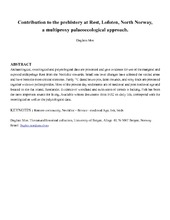Contribution to the prehistory at Røst, Lofoten, North Norway, a multiproxy palaeoecological approach
Journal article
Draft

Åpne
Permanent lenke
https://hdl.handle.net/1956/12754Utgivelsesdato
2016Metadata
Vis full innførselSamlinger
Sammendrag
Archaeological, osteological and palynological data are presented and give evidence for use of the marginal and exposed archipelago Røst from the Neolithic onwards. Small sea level changes have affected the settled areas and have been the most critical elements. Partly 14C dated house pits, farm mounds, and stray finds are presented together with two pollen profiles. Most of the present-day settlements are of medieval and post medieval age and located on the flat island, Røstlandet. Evidence of woodland and cultivation of cereals is lacking. Fish has been the most important source for living. Available written documents from 1432 on daily life, correspond with the osteological as well as the palynological data.